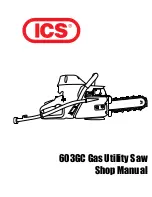
▪ Remove spanners, cut off pieces and the other
items from the saw table, before turning on
the switch.
▪ NEVER wear gloves while working; the wearing
of gloves is only recommended while
cutting tools are being replaced.
▪ Make sure that your hands stay clear of the
cutting line of the saw blade.
▪ NEVER stand in the cutting line of the saw
blade and NEVER let anyone else stand in that
position.
▪ Let the saw run for a few moments before
inserting a workpiece. Listen for vibrations or
knocking of the saw blade, which can indicate
improper mounting or balancing of the
blade.
▪ The equipment may not be used for making
grooves or recesses.
▪ Replace the table insert when it is worn out.
▪ NEVER make any adjustments on the machine
while it is turning. Remove the plug from
the socket before making any adjustments.
▪ If necessary, use a push block. A push block
MUST be used for longitudinal sawing of
smaller workpieces, so that your hands and fingers
are kept well away from the saw blade.
▪ Always store your push block, whenever it is not
in use.
▪ Pay special attention to the instructions that help
to reduce the hazard of KICK BACK.
KICK BACK is a sudden reaction to a jammed, bent
or badly aligned saw blade. KICK
BACK causes the workpiece to be thrown back in
the direction of the operator. KICK
BACK can lead to serious injuries. KICK BACK can
be avoided by keeping your saw blade
sharp, by keeping the rip fence parallel to the saw
blade, by maintaining the riving knife
and the saw guard in good condition and in the right
position, by keeping a good grip on
the workpiece until you have pushed it completely
past the saw blade, and by not sawing
any twisted or skewed wood pieces, or pieces that
do not have a straight edge for moving
along the rip fence, in a longitudinal direction.
▪ Do not carry out any free-hand operations. Freehand
means that you use your hands for
supporting the workpiece, or for leading it with your
hands, instead of using the rip fence
or the mitre block.
▪ NEVER bend over or around the saw blade.
NEVER reach for a workpiece, before the
saw blade has come to a complete stop.
▪ Avoid a sudden or too quick infeed of a
workpiece. Workpieces made of hard material
should be fed in as slowly as possible. Never fold or
turn a workpiece while feeding it into
the saw. If the saw blade jams or ceases to turn
while the workpiece is being fed in, turn
the equipment off immediately. Remove the plug
from the socket. Remove the piece that
is blocking the saw.
▪ NEVER try to remove sawed off chips, and
never touch the saw guard, as long as the saw
blade is turning.
▪ Remove all lose knots from the workpiece,
BEFORE starting to saw.
- Watch what you are doing, demonstrate common
sense and do not use the tool when you are tired.
20 - Check damaged parts.
- Before using the tool for other purposes, examine
it carefully to determine whether it will operate
correctly and accomplish its planned function.
- Check the alignment or locking of the moving parts,
and the absence of any broken parts or any fixing
and other conditions that are likely to affect the
operation of the tool.
- A protective guard or other damaged part should
be repaired or replaced by an approved
maintenance centre, unless stated otherwise in this
instruction manual.
- Have defective switches replaced by an approved
maintenance centre.
- Do not use the tool if the switch does not permit
change from the on state to the off state.
21 – Warning.
- The use of any accessory or any fixing other than
that or those recommended in this instruction
manual can present a risk of injury to persons.
22 - Have the tool repaired by a qualified person.
- This electric tool satisfies the corresponding safety
rules. Repairs should only be made by qualified
persons using original spare parts. Not doing this
can expose the user to significant danger.
ADDITIONAL SAFETY
INSTRUCTIONS
▪ Always wear eye protectors.
▪ Never use the equipment in the presence of
flammable liquids or gases.
▪ NEVER use the equipment when a cutting disc
(and not a saw disc) has been attached.
▪ Before each use, check the saw blade for small
cracks or damages. Replace a cracked or
damaged blade immediately.
▪ Only use saw blades that are recommended by
the manufacturer and that fulfil the EN847-
1 standard.
▪ Always use the accessories that are
recommended by this manual.
▪ Select the correct saw blade for the material
must be sawn.
▪ To reduce the generation of noise, always make
sure that the blade is sharp and clean.
▪ Only use correctly sharpened saw blades.
Never exceed the maximum speed that is
indicated on the saw blade.
▪ Before installing the saw blade, clean the axle,
the flanges (especially the assembly
surfaces) and the hexagonal nut. Incorrect mounting
can lead to vibrations/knocking or
slipping of the saw blade.
▪ Prevent that the saw comes into contact with
metals, such as nails and screws. Search for
and remove all nails, screws and other foreign
materials from the workpiece, before you
start to work.
Содержание CT0092
Страница 3: ......
Страница 5: ...CHANGING THE SAW BLADE The blade supplied with the machine is a blade that can cut only the wood...
Страница 6: ...LASER 2x AAA INTERRUPTEUR ON OFF SCHAKELAARON OFF SWITCHON OF...
Страница 7: ...SAWING SPECIAL WORK PIECES THE MODEL 255 MM CAN ONLY TURN TO THE LEFT...
Страница 15: ...PROCEDURETO CHANGE THE CARBON BRUSH...
Страница 16: ......
Страница 17: ...CANNON TOOLS LTD Add 20 station road Rowley Regis west midlands B65 0JU U K Made in China...



































